2003 GMC SIERRA DENALI ECU
[x] Cancel search: ECUPage 58 of 428
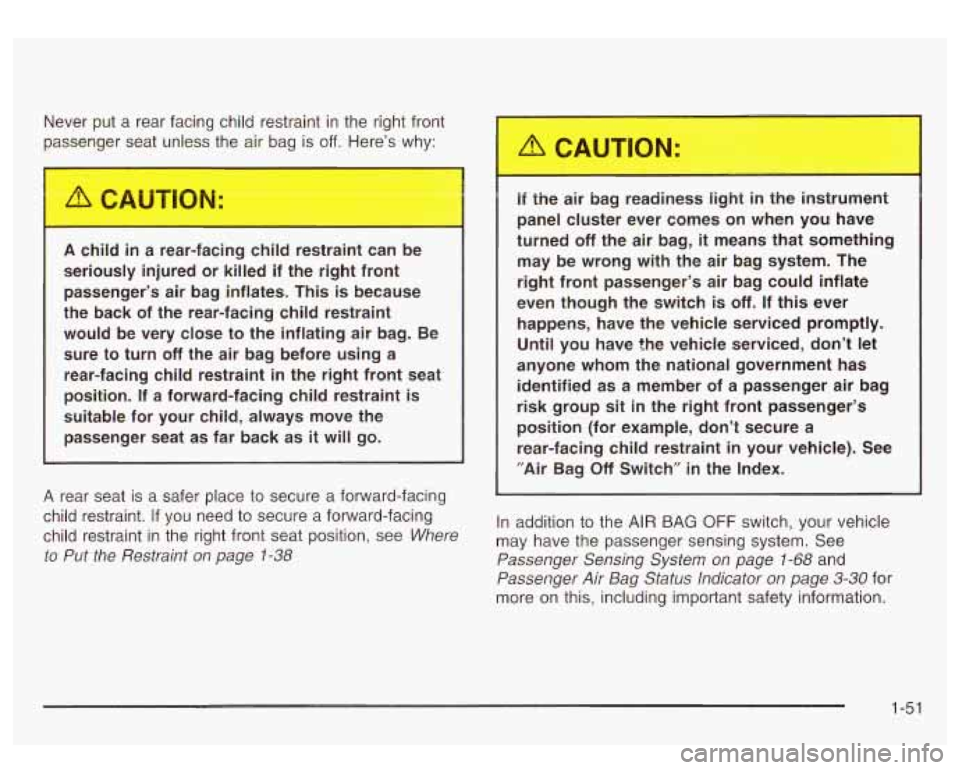
Never put a rear facing child restraint in the right front
passenger seat unless the air bag is
off. Here’s why:
A child in a rear-facing child restraint ca
seriously injured or killed if the right front passenger’s air bag inflates. This is because
the back of the rear-facing child restraint
would be very close to the inflating air bag. Be
sure to turn
off the air bag before using a
rear-facing child restraint
in the right front seat
position. If a forward-facing child restraint
is
suitable for your child, always move the passenger seat as far back as
it will go.
A rear seat is a safer place to secure a forward-facing
child restraint. If you need to secure a forward-facing
child restraint in the right front seat position, see
Where
to Put the Restraint
on page 1-38
If the air bag readiness light in the instrument
panel cluster ever comes on when you have
turned
off the air bag, it means that something
may be wrong with the air bag system. The
right front passenger’s air bag could inflate
even though the switch
is off. If this ever
happens, have the vehicle serviced promptly.
Until you have the vehicle serviced, don’t let
anyone whom the national government has identified as a member of a passenger air bag
risk group
sit in the right front passenger’s
position (for example, don’t secure a
rear-facing child restraint
in your vehicle). See
”Air Bag Off Switch’’
in the Index.
In addition to the
AIR BAG OFF switch, your vehicle
may have the passenger sensing system. See
Passenger Sensing System on page 1-68 and
Passenger Air Bag Status Indicator on page 3-30 for
more on this, including important safety information.
1-51
Page 59 of 428
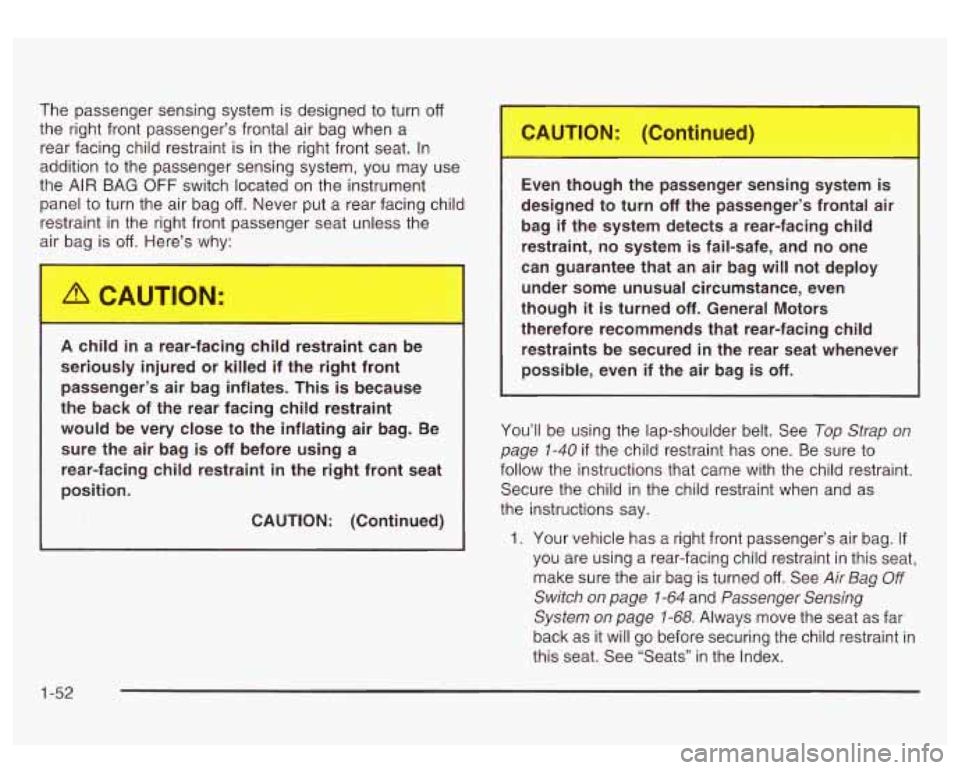
The passenger sensing system is designed to turn off
the right front passenger’s frontal air bag when a
rear facing child restraint is in the right front seat. In
addition to the passenger sensing system, you may use
the AIR BAG
OFF switch located on the instrument
panel to turn the air bag
off. Never put a rear facing child
restraint in the right front passenger seat unless the
air bag is
off. Here’s why:
A child in a rear-facing child restraint can be
seriously injured or killed if the right front
passenger’s air bag inflates. This is because
the back of the rear facing child restraint
would be very close to the inflating air bag. Be
sure the air bag
is off before using a
rear-facing child restraint
in the right front seat
position.
CAUTION: (Continued)
’ Even though the passenger sensing system is
~ designed to turn off the passenger’s frontal air
~ bag if the system detects a rear-facing child
restraint, no system is fail-safe, and no one
can guarantee that an air bag
will not deploy
under some unusual circumstance, even
though
it is turned off. General Motors
therefore recommends that rear-facing child restraints be secured in the rear seat whenever
possible, even if the air bag is
off.
You’ll be using the lap-shoulder belt. See Top Strap on
page
1-40 if the child restraint has one. Be sure to
follow the instructions that came with the child restraint.
Secure the child in the child restraint when and as
the instructions say.
1. Your vehicle has a right front passenger’s air bag. If
you are using a rear-facing child restraint in this seat,
make sure the air bag is turned
off. See Air Bag Off
Switch on page 1-64 and Passenger Sensing
System
on page 1-68. Always move the seat as far
back as it will
go before securing the child restraint in
this seat. See ‘Seats” in the Index.
1-52
Page 60 of 428
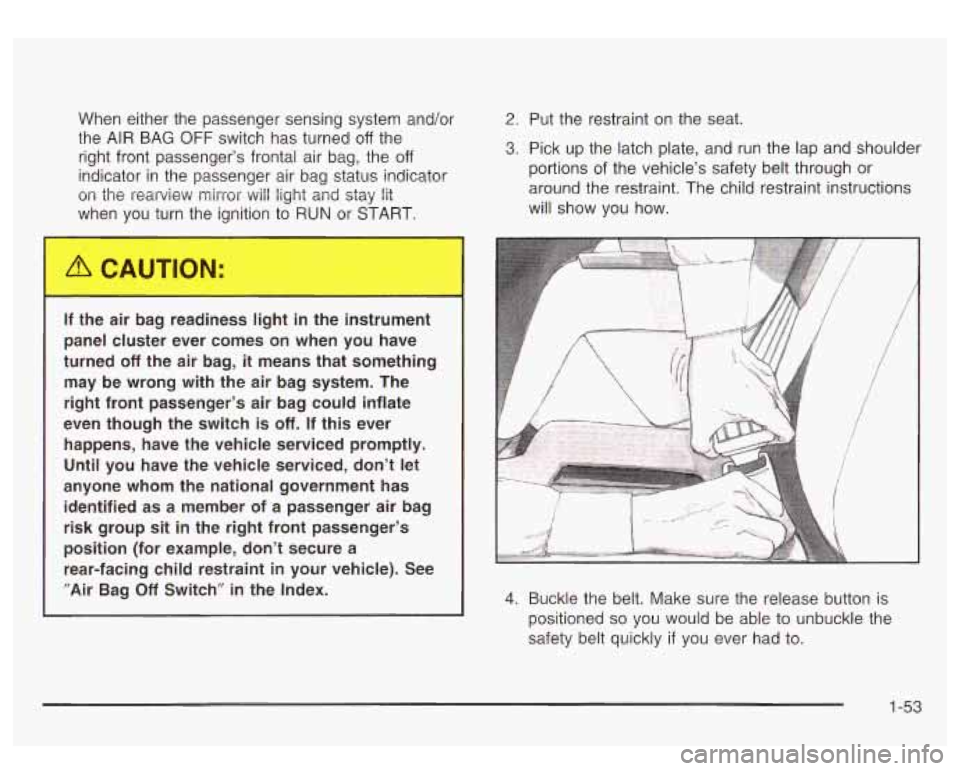
When either the passenger sensing system and/or
the AIR BAG
OFF switch has turned off the
right front passenger’s frontal air bag, the
off
indicator in the passenger air bag status indicator
on the rearview mirror will light and stay lit
when
y-” turn the ignition to RUN or START.
2. Put the restraint on the seat.
3. Pick up the latch plate, and run the lap and shoulder
portions
of the vehicle’s safety belt through or
around the restraint. The child restraint instructions
will show you how.
If the air bag readiness light
in the instrument
panel cluster ever comes
on when you have
turned
off the air bag, it means that something
may be wrong with the air bag system. The
right front passenger’s air bag could inflate
even though the switch
is off. If this ever
happens, have the vehicle serviced promptly.
Until
you have the vehicle serviced, don’t let
anyone whom the national government has identified as a member of a passenger air bag
risk group sit in the right front passenger’s
position (for example, don’t secure a
rear-facing child restraint
in your vehicle). See
”Air Bag
Off Switch” in the Index. 4. Buckle the belt. Make sure the release button is
positioned
so you would be able to unbuckle the
safety belt quickly
if you ever had to.
1-53
Page 61 of 428
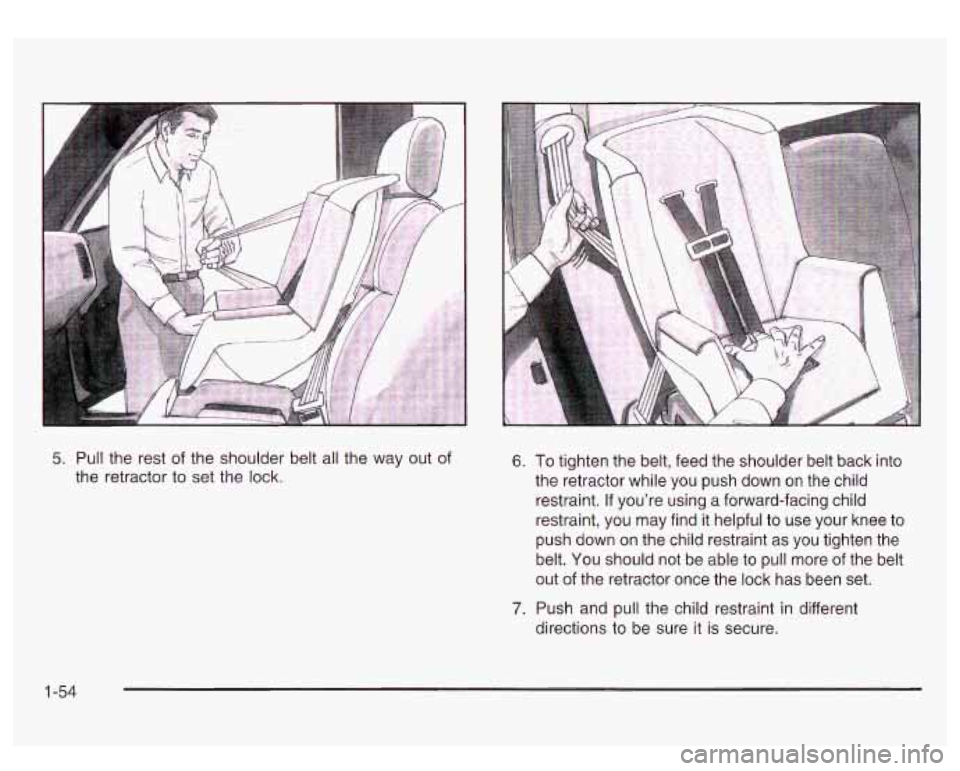
5. Pull the rest of the shoulder belt all the way out of
the retractor to set the lock. 6.
7.
To tighten the
belt, feed the shoulder belt back into
the retractor while you push down on the child
restraint.
If you’re using a forward-facing child
restraint, you may find it helpful to use your knee to
push down on the child restraint as you tighten the
belt. You should not be able to pull more of the belt
out of the retractor once the lock has been set.
Push and pull the child restraint in different
directions to be sure it is secure.
1-54
Page 65 of 428
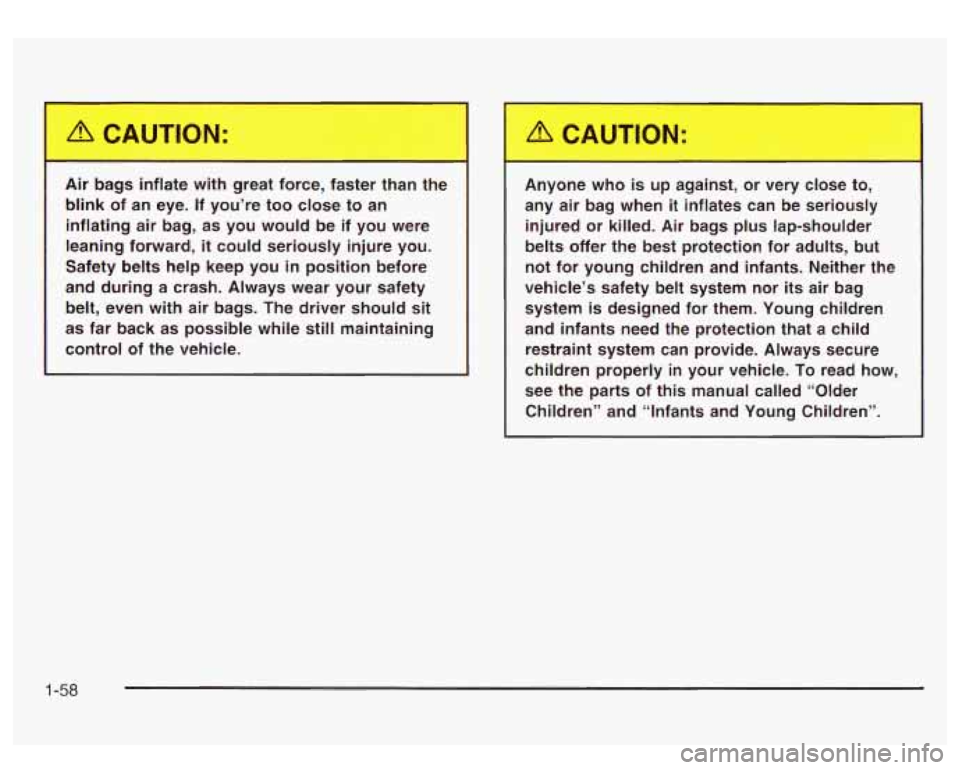
Air bags inflate with great force, faster than the blink of an eye. If you’re too close to an
inflating air bag, as you would be if you were
leaning forward,
it could seriously injure you.
Safety belts help keep you
in position before
and during a crash. Always wear your safety
belt, even with air bags. The driver should sit
as far back as possible while
still maintaining
control of the vehicle. Anyone who is up against, or very close
to,
any air bag when
it inflates can be seriously
injured or killed. Air bags
plus lap-shoulder
belts offer the best protection for adults, but
not for young children and infants. Neither the
vehicle’s safety belt system nor its air bag
system
is designed for them. Young children
and infants need the protection that a child restraint system can provide. Always secure
children properly in your vehicle. To read how,
see the parts of this manual called “Older
Children” and “Infants and Young Children”.
1-58
Page 74 of 428
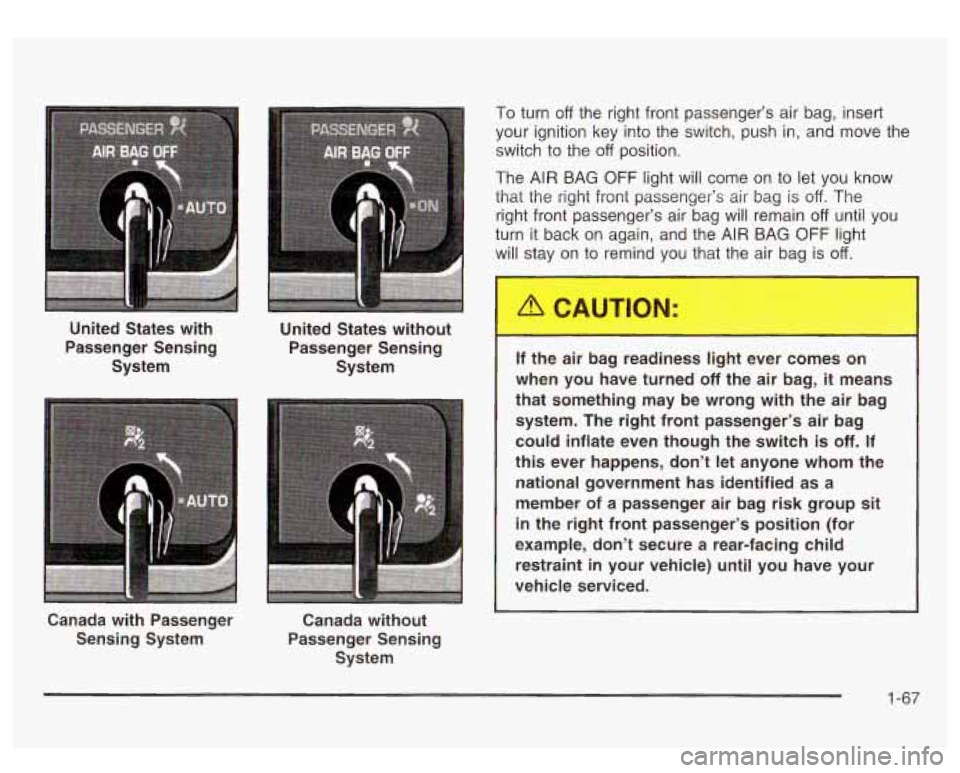
United States with
Passenger Sensing
System
Canada with Passenger
Sensing System United
StaG without
Passenger Sensing System
Canada without
Passenger Sensing System To turn
off the
right front passenger’s air bag, insert
your ignition key into the switch,
push in, and move the
switch
to the off position.
The AIR BAG
OFF light will come on to let you know
that the right front passenger’s air bag is
off. The
right front passenger’s air bag will remain
off until you
turn it back on again, and the
AIR BAG OFF light
will stay on
to remind you that the air bag is off.
If the ai. Jag readiness light ever comes on
when you have turned
off the air bag, it means
that something may be wrong with the air bag system. The right front passenger’s air bag
could inflate even though the switch
is off. If
this ever happens, don’t
let anyone whom the
national government has identified as a
member of
a passenger air bag risk group sit
in the right front passenger’s position (for
example, don’t secure a rear-facing child
restraint in your vehicle)
until you have your
vehicle serviced.
1-67
Page 77 of 428
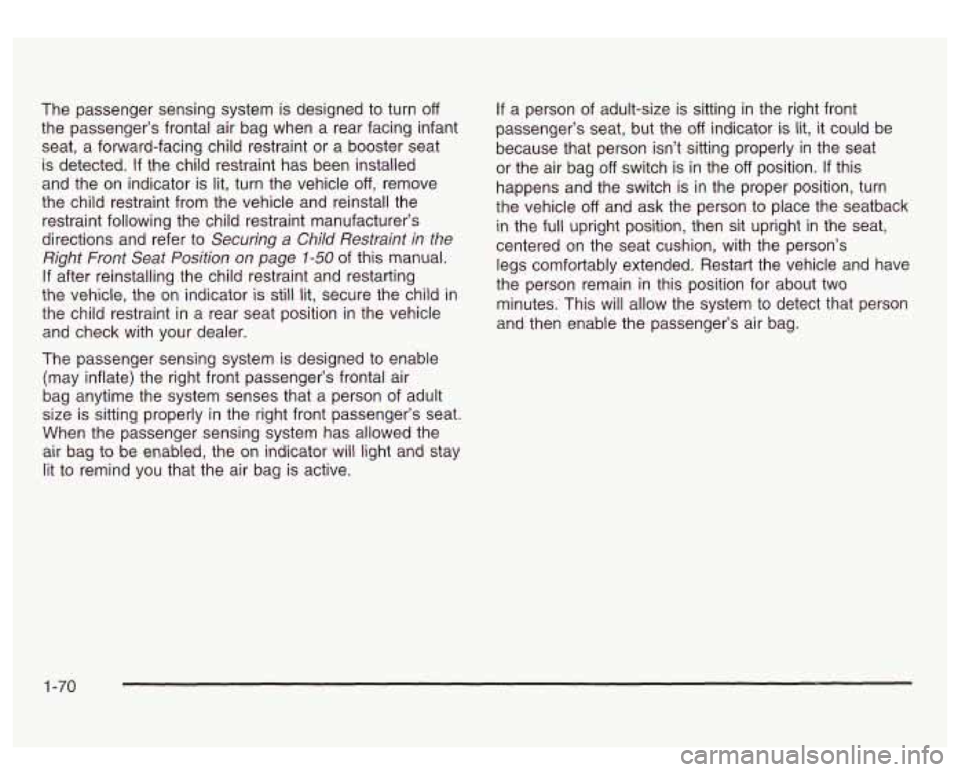
The passenger sensing system is designed to turn off
the passenger’s frontal air bag when a rear facing infant
seat, a forward-facing child restraint or a booster seat
is detected.
If the child restraint has been installed
and the on indicator is lit, turn the vehicle
off, remove
the child restraint from the vehicle and reinstall the
restraint following the child restraint manufacturer’s
directions and refer to
Securing a Child Restraint in the
Right Front Seat Position
on page 1-50 of this manual.
If after reinstalling the child restraint and restarting
the vehicle, the on indicator is still lit, secure the child in
the child restraint in a rear seat position in the vehicle
and check with your dealer.
The passenger sensing system is designed to enable
(may inflate) the right front passenger’s frontal air
bag anytime the system senses that
a person of adult
size is sitting properly in the right front passenger’s seat.
When the passenger sensing system has allowed the
air bag to be enabled, the on indicator will light and stay
lit to remind you that the air bag is active.
If a person of adult-size is sitting in the right front
passenger’s seat, but the
off indicator is lit, it could be
because that person isn’t sitting properly in the seat
or the air bag
off switch is in the off position. If this
happens and the switch is in the proper position, turn
the vehicle
off and ask the person to place the seatback
in the full upright position, then sit upright in the seat,
centered on the seat cushion, with the person’s
legs comfortably extended. Restart the vehicle and have
the person remain in this position for about two
minutes. This will allow the system to detect that person
and then enable the passenger’s air bag.
1-70
Page 89 of 428
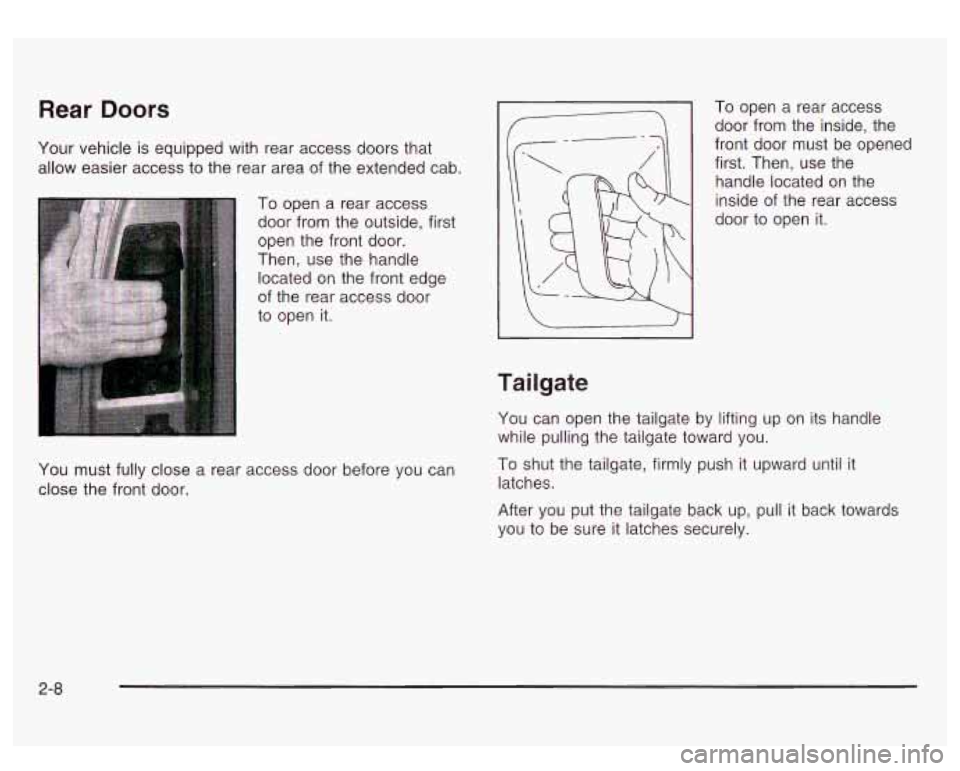
Rear Doors
Your vehicle is equipped with rear access doors that
allow easier access to the rear area of the extended cab.
To open a rear access
door from the outside, first
open the front door.
Then, use the handle
located on the front edge
of the rear access door
to open it.
Tailgate
You must fully close a rear access door before you can
close the front door. To open a rear access
door from the inside, the
front door must be opened
first. Then, use the
handle located on the
inside of the rear access
door to open it.
You can open the tailgate by lifting up on its handle
while pulling the tailgate toward you.
To shut the tailgate, firmly push it upward until it
latches.
After you put the tailgate back up, pull it back towards
you to be sure it latches securely.
2-8